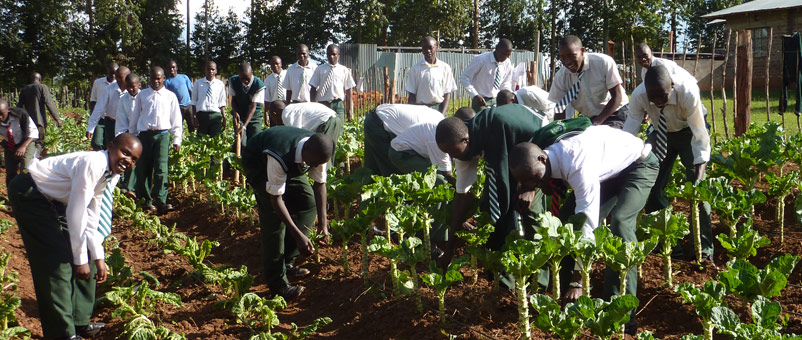As part of our ongoing series that explores the state of the negotiations on the Sustainable Development Goals, we asked Rajul Pandya-Lorch, Sivan Yosef, and Laura Zseleczky of the International Food Policy Research Institute (IFPRI) to explain why smallholder farmers should be a key consideration at the UN World Conference on Disaster Risk Reduction, which is taking place in Sendai, Japan, this week.
As delegates gather today for the Third UN World Conference on Disaster Risk Reduction in Sendai, we hope that building up the resilience of smallholder farmers remains a key theme of their vital discussions. Incorporating the experience of farmers engaged in all aspects of agriculture into the post-2015 framework for disaster risk reduction can go a long way in building up the resilience of the majority of the world’s poor and vulnerable people, and creating a global food system that is sustainable, healthy, and resilient to disasters and other shocks.
Every year, the food and nutrition security of millions of people around the world is affected by a variety of shocks and stresses. These shocks range from natural disasters such as droughts, flooding, and earthquakes to financial crises, food price volatility, conflict, and political instability to everyday stresses such as poverty, illness, and malnutrition. As different regions undergo major shifts such as urbanization, dietary transitions, and climate change, some of these shocks may increase in frequency, intensity, or impact in the coming years.
 Smallholder farmers are especially vulnerable to shocks. While smallholders produce most of the food in developing regions of the world, they nevertheless lack the tools to manage climate variability, face inefficient or nonexistent markets, and lack agricultural inputs and services that can help smooth shocks and stresses. The impact of these shocks can be detrimental, especially when considering that malnutrition has lifelong and intergenerational effects on productivity, income, educational attainment, and physical and cognitive development. Conversely, the wellbeing and livelihoods of farmers also affect the stability of their communities and beyond. The secondary effects of drought in 2010, coupled with unfavorable trade policies, affected a large percentage of agricultural land in affected regions, and led to food prices to spike around the world, contributing to social unrest in some areas. How then can we build up smallholders’ resilience for food and nutrition security, or help farmers, their communities, and the global food system to which they contribute get better at predicting, preventing, coping with, and recovering from shocks?
Smallholder farmers are especially vulnerable to shocks. While smallholders produce most of the food in developing regions of the world, they nevertheless lack the tools to manage climate variability, face inefficient or nonexistent markets, and lack agricultural inputs and services that can help smooth shocks and stresses. The impact of these shocks can be detrimental, especially when considering that malnutrition has lifelong and intergenerational effects on productivity, income, educational attainment, and physical and cognitive development. Conversely, the wellbeing and livelihoods of farmers also affect the stability of their communities and beyond. The secondary effects of drought in 2010, coupled with unfavorable trade policies, affected a large percentage of agricultural land in affected regions, and led to food prices to spike around the world, contributing to social unrest in some areas. How then can we build up smallholders’ resilience for food and nutrition security, or help farmers, their communities, and the global food system to which they contribute get better at predicting, preventing, coping with, and recovering from shocks?
In May 2014, with the concept of resilience gaining traction in the development community, the International Food Policy Research Institute (IFPRI) and its 2020 Vision Initiative held an international conference in Addis Ababa, Ethiopia, with the support of Farming First and other partners. The conference, “Building Resilience for Food and Nutrition Security,” brought together 800 people from many fields and sectors to consider what resilience means; what shocks we can expect in the coming years; how we can measure and build resilience; and, as the deadline for the Millennium Development Goals draws near, how we can incorporate resilience into the post-2015 development agenda.
The conference and its associated papers, briefs, and other resources converged on a few key conclusions on reducing risk for farmers, and the benefits of doing so. Country and regional experiences show that raising agricultural growth and farmers’ incomes will increase the resilience not only of the farmers themselves but also of society at large by providing a stable buffer against shocks. Introducing new technologies, such as mobile phones that connect farmers to markets, in a participatory way that includes farmers’ own knowledge and input, can help move them up and away from subsistence-level livelihoods.

The event identified a number of specific actions that can be taken now to build up the resilience of farmers. These include, among others:
- Empower vulnerable and excluded people by ensuring their access to the same productive resources that others receive, including credit, extension services, and agricultural inputs such as diverse modern seeds, improved fertilizers, mechanization equipment, and rural advisory and extension services for smallholder farmers, especially women;
- Keep farmers central in the process of building resilience to climate change by focusing small-scale mitigation and adaptation efforts in areas with degraded land, highly variable weather, and frequent weather shocks;
- Create and maintain efficient and well-regulated futures and exchange markets for commodities to help farmers and other agents mitigate and hedge against risks;
- Invest in crops and products that may be more resilient to climate, drought, and pests, but are still readily accessible to smallholders, such as millet or sorghum, or horticultural crops, which have high nutritional value but can also provide higher incomes for smallholder households; and
- Shift the focus of agricultural research and development to go beyond just increasing yields and consider other important crop characteristics, such as nutritional value; tolerance to stresses like heat, drought, and salt; and greater water and energy efficiency.
To explore more expert blogs, videos and infographics on this topic, produced by Farming First and the International Food Policy Research Institute, visit our ‘resilience’ hub.





